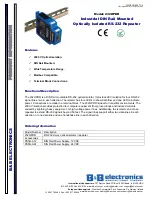
WESTELL.COM
© 2016 Westell Technologies
20 April 2016 Doc. No. 030-300736 rB
1.877.844.4274
Page 22 of 50
CAUTION
Close proximity to the donor or server antennas with the repeater in
operation may expose users or installers to RF fields that exceed FCC limits
for human exposure.
Turn power to the repeater off when connecting or disconnecting cables.
5.2
Donor Antenna Installation Guidelines
Accurately determine the azimuth to the donor site. Obtain the donor site information and approval from
the service provider/carrier.
Ensure that the radiation path to the donor site is unobstructed.
Mount the donor antenna at or toward the edge of the roof, in the direction of the donor site. Avoid having
the RF signal from the donor pass above the location(s) of the service antennas. Normally, the service
antennas are installed behind and below the donor antenna, as viewed from above. This approach helps
avoid interference and feedback to and from the service antennas.
Normally, mounting the donor antenna higher will allow a less obstructed path to the donor site. However,
in high traffic metro areas, avoid mounting the donor antenna higher than necessary, as the quality of the
donor signal may become less stable and it is more likely to encounter adjacent channel interference.
When possible, shield the rear of a donor antenna by locating it so that any HVAC units and/or penthouse
structures are behind the antenna, relative to the donor cell site location.
5.3
Indoor Antenna Installation Guidelines
Use omnidirectional antennas (see section 2.4. Optional Accessories) indoors and locate them centrally with
respect to the intended coverage area to minimize signal leakage to the outside. Only use directional
antennas indoors in special cases when higher gain and directionality would be helpful and RF exposure
limits will not be exceeded.
To avoid repeater uplink overload and gain limiting, mount the indoor antennas away from areas where
mobile subscribers frequently use their phones, such as desks or dispatch areas.
To determine the quantity and locations of indoor antennas, measure Received Signal Strength Indication
(RSSI) using DM Tool software to determine areas of weak signals. These are the approximate areas where
indoor antennas may be needed.
Be aware that the signal from an indoor antenna, in most cases, can be expected to penetrate approximately
two standard sheet rock walls to reach users. If the signal must travel through more than two walls, or if
the walls are made of materials other than sheet rock, it may be necessary to split the available signal and
add more antennas.
Содержание PS51080
Страница 50: ...WESTELL COM Westell Technologies 030 300736 rB...
















































